Useful Tips
- Tip 1: Once you have located a book on your topic click on the subject headings of the catalog record. This can lead you to additional books on the same topic.
- Tip 2: Look to see if the catalog record has a summary or table of contents of the book and is available in other editions.
- Tip 3: If a record says networked resource it is usually available online.
- Tip 4: When doing keyword searching, try combining keywords/phrases. Be aware of the differences between broad and narrower, search:
Selected Books @ Cornell and Beyond
-
 Darfur: Genocide Before Our Eyes
by
Call Number: Africana Library DT157.672 .D37 2005This book is a compilation of essays which provides background material, and opinion of the crisis in Darfur. This book may be helpful for teachers for it contains topic suggestions, comparative genocide, and human rights facts. In addition, it has references, maps and other source material on the crime of genocide.
Darfur: Genocide Before Our Eyes
by
Call Number: Africana Library DT157.672 .D37 2005This book is a compilation of essays which provides background material, and opinion of the crisis in Darfur. This book may be helpful for teachers for it contains topic suggestions, comparative genocide, and human rights facts. In addition, it has references, maps and other source material on the crime of genocide. -
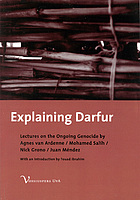 Explaining Darfur: Lectures on the Ongoing Genocide
by
Call Number: Africana Library DT159.6.D27 E97 2006Explaining Darfur gives a historical analysis of the conflict in Darfur. This book consists of five essays by important scholars in the field. The essays are: “Introduction to the Conflict in Darfur/West Sudan,” by Fouad Ibrahim; “The Road to Darfur Leads through Khartoum,” by Agnes van Ardenne-van der Hoeven; “Africa’s Governance Deficit, Genocide, and Ethnocide,” by M.A. Mohamed Salih; “Darfur: The International Community’s Failure to Protect,” by Nick Grono; and “Possibilities for Genocide Prevention,” by Juan E. Méndez. These essays provide valuable background material which allows the reader to gain a better understanding of the conflict. The authors also introduce various nonviolent ways of resolving the crisis. A critique of the international community’s response to the crisis is also given.
Explaining Darfur: Lectures on the Ongoing Genocide
by
Call Number: Africana Library DT159.6.D27 E97 2006Explaining Darfur gives a historical analysis of the conflict in Darfur. This book consists of five essays by important scholars in the field. The essays are: “Introduction to the Conflict in Darfur/West Sudan,” by Fouad Ibrahim; “The Road to Darfur Leads through Khartoum,” by Agnes van Ardenne-van der Hoeven; “Africa’s Governance Deficit, Genocide, and Ethnocide,” by M.A. Mohamed Salih; “Darfur: The International Community’s Failure to Protect,” by Nick Grono; and “Possibilities for Genocide Prevention,” by Juan E. Méndez. These essays provide valuable background material which allows the reader to gain a better understanding of the conflict. The authors also introduce various nonviolent ways of resolving the crisis. A critique of the international community’s response to the crisis is also given. -
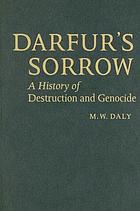 Darfur's Sorrow: A History of Destruction and Genocide.
by
Call Number: Olin Library DT159.6.D27 D35 2007Noted scholar and author on the Middle East and Northeast Africa, M.W. Daly writes a stunning account of the historical chain of events that has lead to the current crisis in Darfur. This compelling analysis of the Darfur crisis traces the story from the origins of the Fur state in the seventeenth century to Darfur's annexation. Daly points out how years of neglect, and underdevelopment in the region left it unprepared for independence. He also reports on how the people today are locked in conflict, terrorized by the Arab militia known as Janjaweed. The book also contains a chronology, glossary, and a selected bibliography.
Darfur's Sorrow: A History of Destruction and Genocide.
by
Call Number: Olin Library DT159.6.D27 D35 2007Noted scholar and author on the Middle East and Northeast Africa, M.W. Daly writes a stunning account of the historical chain of events that has lead to the current crisis in Darfur. This compelling analysis of the Darfur crisis traces the story from the origins of the Fur state in the seventeenth century to Darfur's annexation. Daly points out how years of neglect, and underdevelopment in the region left it unprepared for independence. He also reports on how the people today are locked in conflict, terrorized by the Arab militia known as Janjaweed. The book also contains a chronology, glossary, and a selected bibliography. -
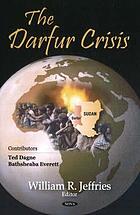 The Darfur Crisis
by
Call Number: Africana Library DT157.672 .D35 2008This book provides background material on the complex nature of the crisis in Darfur. Detail is given to the many different groups which has played a role in this crisis. For example, in this study it is explained that on the one side of this armed conflict there is the Sudanese military and the Janjaweed, a militia group. On the other side are a host of rebel groups, like the Sudan Liberation Movement and the Justice and Equality Movement. The authors in the first chapter try to explain this relationship, as it led to the current humanitarian disaster, which in part has displaced thousands of people. For those who are not familiar with the Sudan, there is also a chapter dedicated to country profile, which provide basic information on the make-up of Sudan.
The Darfur Crisis
by
Call Number: Africana Library DT157.672 .D35 2008This book provides background material on the complex nature of the crisis in Darfur. Detail is given to the many different groups which has played a role in this crisis. For example, in this study it is explained that on the one side of this armed conflict there is the Sudanese military and the Janjaweed, a militia group. On the other side are a host of rebel groups, like the Sudan Liberation Movement and the Justice and Equality Movement. The authors in the first chapter try to explain this relationship, as it led to the current humanitarian disaster, which in part has displaced thousands of people. For those who are not familiar with the Sudan, there is also a chapter dedicated to country profile, which provide basic information on the make-up of Sudan. -
 Darfur in Flames: Atrocities in Western Sudan
by
Call Number: Held by Borrow DirectThis book provides a historical background to the situation in Darfur. It discusses the Sudanese government’s policy of forced displacement, abuses by government-allied militias and rebels, the cross-border conflict in Chad, and humanitarian implications. It provides recommendations to Sudan, Chad, rebel groups, the United Nations, the World Food Programme, and others.
Darfur in Flames: Atrocities in Western Sudan
by
Call Number: Held by Borrow DirectThis book provides a historical background to the situation in Darfur. It discusses the Sudanese government’s policy of forced displacement, abuses by government-allied militias and rebels, the cross-border conflict in Chad, and humanitarian implications. It provides recommendations to Sudan, Chad, rebel groups, the United Nations, the World Food Programme, and others. -
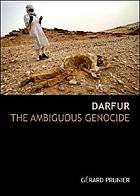 Darfur: The Ambiguous Genocide
by
Call Number: Olin Library DT159.6.D27 P78 2005The Ambiguous Genocide provides an overview of the conflict in Darfur. Gérard Prunier discusses the origin of this crisis, and those involved. Prunier also writes about the local and regional politics, and the relations between Darfur and the Khartoum government. Included in the book is a glossary of Arabic terms. He also provides a listing of key abbreviations, and a map of the Darfur region.
Darfur: The Ambiguous Genocide
by
Call Number: Olin Library DT159.6.D27 P78 2005The Ambiguous Genocide provides an overview of the conflict in Darfur. Gérard Prunier discusses the origin of this crisis, and those involved. Prunier also writes about the local and regional politics, and the relations between Darfur and the Khartoum government. Included in the book is a glossary of Arabic terms. He also provides a listing of key abbreviations, and a map of the Darfur region. -
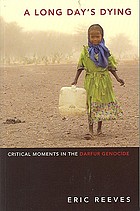 A Long Day’s Dying: Critical Moments in the Darfur Genocide
by
Call Number: Africana Library DT159.6.D27 R448 2007Eric Reeves provides background information on how the Darfurians have been slaughter. He contents that this is mostly at the hands of the Janjaweed. He does not pull any punches laying blame of this killing on the government in Khartoum. He also puts to rest the Western notion that it is a fight between Christians vs. Muslims. He reports on the complex relationships among the many tribes, and how Muslims as well as Christians have been killed. In addition, he provides color photos which helps tell the story of this human tragedy. Included in the appendixes are: 1. The text of the 1984 United Nations Convention on the Prevention and Punishment of the Crime of Genocide; 2. The United Nations Inter-Agency Fact Finding and Rapid Assessment Mission: Kailek Town, South Darfur; and 3. The United Nations Security Council Resolutions 1556 (July 30, 2004) and 1706 (August 31, 2006). There is also a selected bibliography which leans heavily on news wire services, and numerous human rights reports from agencies such as the Human Rights Watch, Amnesty International, Physicians for Human Rights, and the International Crisis Group.
A Long Day’s Dying: Critical Moments in the Darfur Genocide
by
Call Number: Africana Library DT159.6.D27 R448 2007Eric Reeves provides background information on how the Darfurians have been slaughter. He contents that this is mostly at the hands of the Janjaweed. He does not pull any punches laying blame of this killing on the government in Khartoum. He also puts to rest the Western notion that it is a fight between Christians vs. Muslims. He reports on the complex relationships among the many tribes, and how Muslims as well as Christians have been killed. In addition, he provides color photos which helps tell the story of this human tragedy. Included in the appendixes are: 1. The text of the 1984 United Nations Convention on the Prevention and Punishment of the Crime of Genocide; 2. The United Nations Inter-Agency Fact Finding and Rapid Assessment Mission: Kailek Town, South Darfur; and 3. The United Nations Security Council Resolutions 1556 (July 30, 2004) and 1706 (August 31, 2006). There is also a selected bibliography which leans heavily on news wire services, and numerous human rights reports from agencies such as the Human Rights Watch, Amnesty International, Physicians for Human Rights, and the International Crisis Group. -
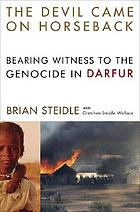 The Devil Came on Horseback: Bearing Witness to the Genocide in Darfur
by
Call Number: Africana Library DT159.6.D27 S74 2007Brain Steidle, former United States Marine, and military observer for the African Union (AU), and his sister Gretchen Steidle, reports how the government in Sudan condoned slavery, allowed rape to use used as a weapon of war, chased Blacks out of their homeland, and practiced genocide. In the prologue Steidle writes, “A government [Sudanese], abetted by others incited to hatred, is attempting to ‘cleanse’ an entire people—where Arab Muslims kill African Muslims because the Africans are ‘too black.’” He goes on point out that while this is going on the world stands by and does nothing of importance to stop this genocide.
The Devil Came on Horseback: Bearing Witness to the Genocide in Darfur
by
Call Number: Africana Library DT159.6.D27 S74 2007Brain Steidle, former United States Marine, and military observer for the African Union (AU), and his sister Gretchen Steidle, reports how the government in Sudan condoned slavery, allowed rape to use used as a weapon of war, chased Blacks out of their homeland, and practiced genocide. In the prologue Steidle writes, “A government [Sudanese], abetted by others incited to hatred, is attempting to ‘cleanse’ an entire people—where Arab Muslims kill African Muslims because the Africans are ‘too black.’” He goes on point out that while this is going on the world stands by and does nothing of importance to stop this genocide. -
Genocide in Darfur: Investigating the Atrocities in the Sudan by
Call Number: Olin Library DT159.6.D27 G464 2006This book is comprised of essays from contributors who were involved in designing the project and hiring and training investigators, interpreters, and support personnel; US government and nongovernmental organization (NGO) officials involved in the genesis of the project as well as the analysis of the data; and numerous scholars, not all of whom were directly involved with the project, who critique aspects of the documentation project as well as its significance.
